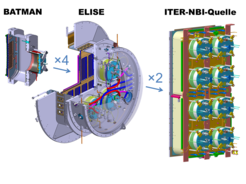Development of sources of negative ions for ITER
Owing to the much higher particle energies demanded by ITER its neutral beam injectors have to work with ion sources that produce negatively instead of positively charged hydrogen ions. The design of these sources is based on prototypes developed at IPP.
The typical particle energies of present-day systems are in the range between 50 keV and 130 keV. For comparison, the thermal energy in the plasma center is at maximum 15 keV. However, owing to its size ITER demands a significantly higher particle energy of 1 MeV for its neutral beam injection. At this high energy neutralization of positive hydrogen ions becomes very inefficient. Therefore, ion sources have to be used that produce negative hydrogen ions.
Neutral beam injection on ITER will consist of two identical systems, each equipped with one ion source with an extraction area of 1.9 × 0.9 m2 delivering an extracted ion current of 40 A and a heating power of 16.5 MW. Additionally, the diagnostics injector provided by India will use an almost identical ion source.
The radio frequency driven sources of negative ions developed by IPP‘s neutral beam injection group have been selected as the reference design for ITER in 2007.

Currently, the group operates two test beds:
BATMAN features a small ion source with a single radio frequency driver, corresponding approximately to one eighth of the ITER source . This test stand offers great experimental flexibility and is equipped with a very comprehensive set of diagnostics.
ELISE has an ion source of half the size of the ITER NBI sources that is equipped with four radio frequency drivers. This test bed investigates mainly the source behaviour in long pulses and questions related to size scaling. ELISE is an important milestone on the way to the construction and operation of the prototype NBI injectors for ITER.
